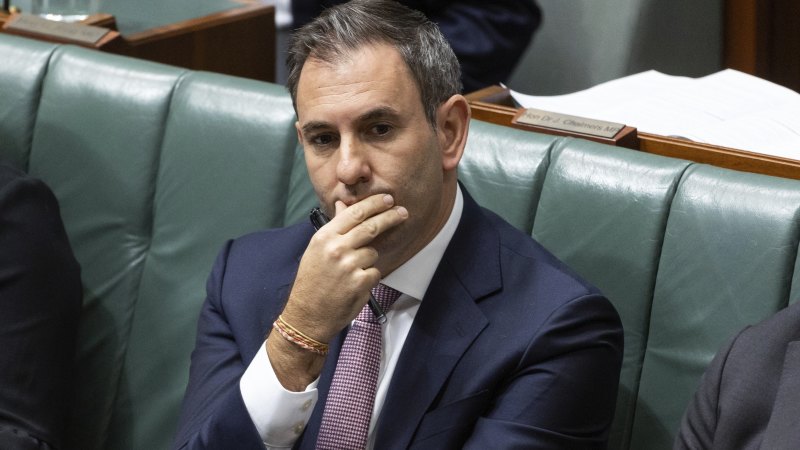Beating inflation shouldn’t just be left to higher interest rates
But the rapid rise in the cost of living during the year caused workers to demand and receive higher pay rises, even though those rises generally fell well short of the rise in prices.
Loading
So all the people who already had jobs paid more tax, too. But not only that. Our “progressive” income tax scale – where successive slices of your income are taxed at progressively higher rates – means that pay rises are taxed at a higher rate than you paid on your existing income.
Ordinary mortals call this “bracket creep”. Economists call it “fiscal drag”. Either way, the higher rate of tax workers paid on their pay rises also made a bigger-than-expected contribution to income tax collections and the budget balance.
Note that this unexpected move from deficit to surplus in the financial year just past, this underestimation of the strength of tax collections, has implications not only for the size of the government’s debt at June 2023, it has implications for the size of tax collections in the next few years, as well as for the amount of interest we’ll have to pay on that debt this year and every year until it’s repaid (which it won’t be).
Compared with what we thought less than 16 months ago, the feds’ debt prospects aren’t nearly as bad as we feared.
In Frydenberg’s budget in March last year, the projected cumulative deficit for the five financial years to June 2026 was just over $300 billion. By the budget in May, this had dropped to $115 billion.
And now that we know last year’s surplus will be about $20 billion, the revised total projected underlying addition to government debt should be well under $100 billion.
Get it? Compared with what we thought less than 16 months ago, the feds’ debt prospects aren’t nearly as bad as we feared. And the size of our “structural” deficit – the size of the deficit that remains after you’ve allowed for the ups and downs of the business cycle – isn’t nearly as big, either.
Which suggests it’s time we had another think about our decision in the late 1970s – along with all the other rich economies – to shift the primary responsibility for managing the macroeconomy from the budget (“fiscal policy”) to the central bank and its interest rates (“monetary policy”).
One of the arguments used by the advocates of this shift was that fiscal policy was no longer effective in stimulating the economy. But our remarkably strong growth since the end of the pandemic lockdowns shows how amazingly effective fiscal policy is.
It’s now clear that fiscal “multipliers” – the extent to which an extra $1 of deficit spending adds to the growth in real GDP – are much higher than we believed them to be.
We know that a big part of the recent leap in prices was caused by shocks to the supply (production) side of the economy arising from the pandemic and the Russia-Ukraine war. But central banks have argued that a second cause was excessive demand (spending), which happened because the stimulus applied to cushion the effect of lockdowns proved far more than needed.
If so, most of that stimulus came from fiscal policy. Our official interest rate was already down to 0.75 per cent before the pandemic began. So, further proof of how powerful fiscal stimulus still is.
But another implication of the $20 billion surplus is that the stimulus wasn’t as great – and its ultimate cost to the budget wasn’t as great – as we initially believed it would be.
In the budget of October 2020, the expected deficit of $214 billion in 2020-21 was overestimated by $80 billion. In the budget of May 2021, the expected deficit of $107 billion in 2021-22 was overestimated by $75 billion. And, as we’ve seen, the deficit for 2022-23 was initially overestimated almost $100 billion.
This says two things: the fiscal stimulus caused the economy to grow much faster than the forecasters expected, even though the ultimate degree of stimulus – and its cost to the budget – was much less than forecasters expect.
Economists know that the budget contains “automatic stabilisers” that limit the private sector’s fall when the economy turns down, but act as a drag on the private sector when the economy’s booming.
We’ve just been reminded that the budget’s stabilisers are working well and have been working to claw back much of the fiscal stimulus, thereby helping to restrain demand and reduce inflation pressure.
Loading
Whenever departing Reserve Bank governor Dr Philip Lowe has been reminded of the many drawbacks of using interest rates to manage the economy, his reply has always been: sorry, it’s the only instrument I’ve got.
True. But it’s not the only instrument the government has got. It should break the central bank’s monopoly on macro management and make more use of fiscal policy.
Ross Gittins unpacks the economy in an exclusive subscriber-only newsletter every Tuesday evening. Sign up to receive it here.
Stay connected with us on social media platform for instant update click here to join our Twitter, & Facebook
We are now on Telegram. Click here to join our channel (@TechiUpdate) and stay updated with the latest Technology headlines.
For all the latest Education News Click Here
For the latest news and updates, follow us on Google News.
